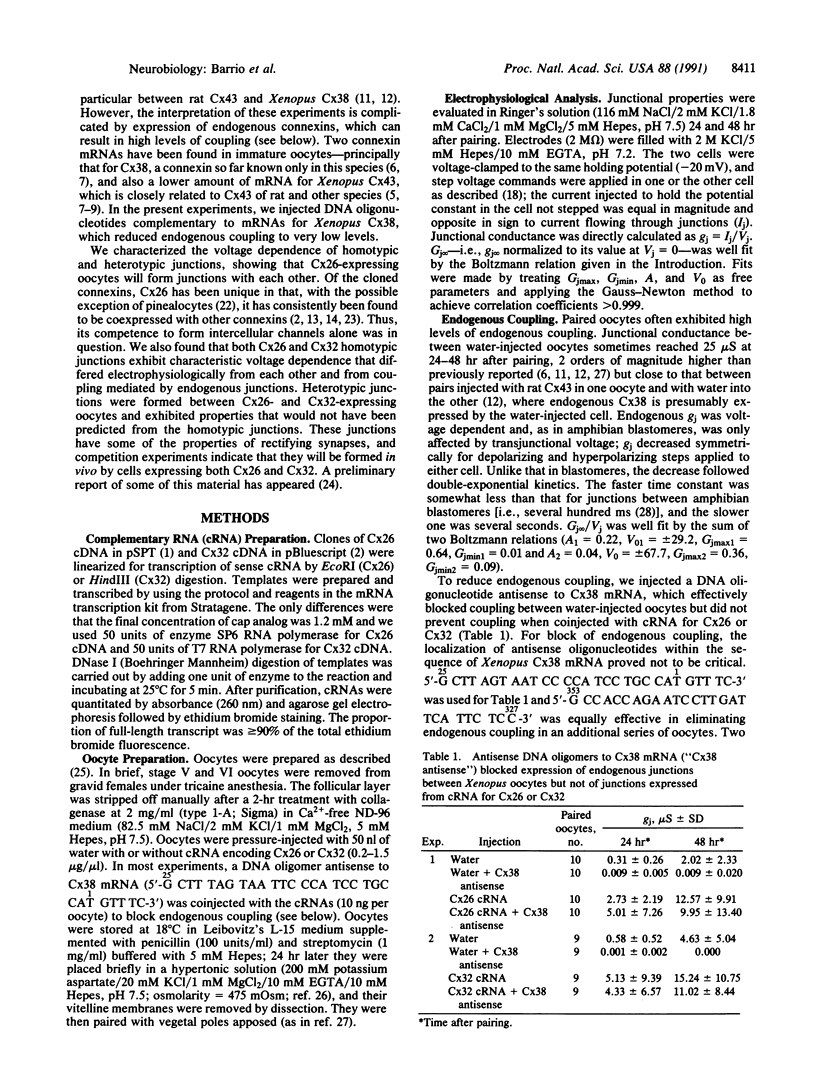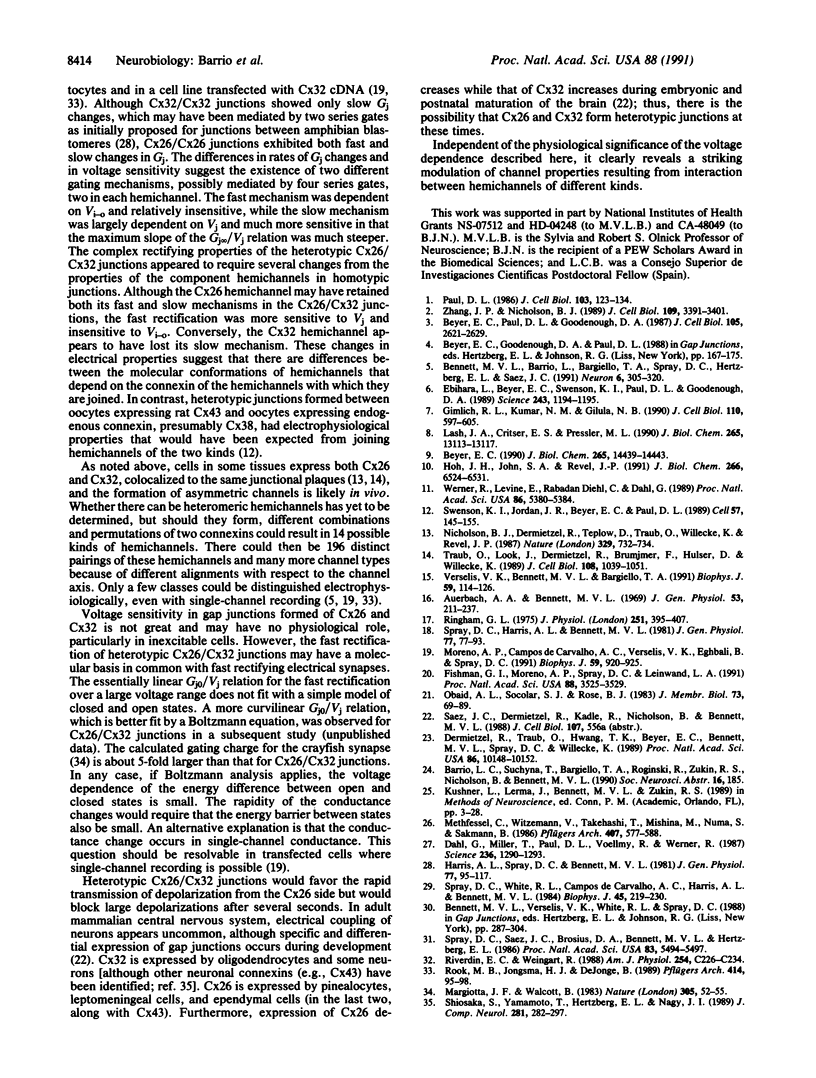Abstract
Gap junctions are formed by a family of homologous proteins termed connexins. Their channels are dodecamers, and homomeric forms differ in their properties with respect to control by voltage and other gating stimuli. We report here the properties of coupling from expression of connexin complementary RNAs (cRNAs; sense to mRNA, antisense to cDNA) in Xenopus oocyte pairs in which endogenous coupling was blocked by injection of DNA oligonucleotides antisense to the mRNA of Cx38, the principal endogenous connexin. We found that a connexin recently sequenced from rat liver, Cx26, formed functional gap junctions whose conductance exhibited voltage dependence with unusual characteristics suggestive of two gating mechanisms. Junctional conductance (gj) was increased to a small degree by depolarization and decreased by hyperpolarization of either cell in a coupled pair, indicating dependence on the potential between the inside and outside of the cells (Vi-o). These changes were fast compared with the resolution of their measurement (ca. 10 ms). On a slower timescale, large transjunctional potentials (Vj) of either sign caused a more substantial decrease in conductance similar to that previously reported for several other gap junctions. Homotypic junctions formed of another connexin, Cx32, exhibited a similar slow dependence on Vj but no dependence on Vi-o. In contrast, heterotypic junctions between an oocyte expressing Cx26 and one expressing Cx32 were electrically asymmetric; they exhibited a greater fast change in gj, which depended, however, on Vj, such that gj increased with relative positivity on the Cx26 side and decreased with relative negativity on the Cx26 side. There was also a large slow decrease in gj in response to Vj for relative positivity on the Cx26 side but not for Vj of the opposite sign. These data indicate that properties of the hemichannels contributed by the two connexins in the heterotypic case were changed from their properties in homotypic junctions. The fast change in gj may involve a mechanism analogous to that at fast rectifying electrical synapses. Experiments in which oocytes expressing Cx32 were paired with oocytes expressing both Cx26 and Cx32 demonstrated that asymmetric junctions would form between oocytes expressing both connexins, thereby confirming their potential relevance in vivo, where the same coupled cells are known to express both proteins.
Full text
PDF




Selected References
These references are in PubMed. This may not be the complete list of references from this article.
- Auerbach A. A., Bennett M. V. A rectifying electrotonic synapse in the central nervous system of a vertebrate. J Gen Physiol. 1969 Feb;53(2):211–237. doi: 10.1085/jgp.53.2.211. [DOI] [PMC free article] [PubMed] [Google Scholar]
- Bennett M. V., Barrio L. C., Bargiello T. A., Spray D. C., Hertzberg E., Sáez J. C. Gap junctions: new tools, new answers, new questions. Neuron. 1991 Mar;6(3):305–320. doi: 10.1016/0896-6273(91)90241-q. [DOI] [PubMed] [Google Scholar]
- Beyer E. C. Molecular cloning and developmental expression of two chick embryo gap junction proteins. J Biol Chem. 1990 Aug 25;265(24):14439–14443. [PubMed] [Google Scholar]
- Beyer E. C., Paul D. L., Goodenough D. A. Connexin43: a protein from rat heart homologous to a gap junction protein from liver. J Cell Biol. 1987 Dec;105(6 Pt 1):2621–2629. doi: 10.1083/jcb.105.6.2621. [DOI] [PMC free article] [PubMed] [Google Scholar]
- Dahl G., Miller T., Paul D., Voellmy R., Werner R. Expression of functional cell-cell channels from cloned rat liver gap junction complementary DNA. Science. 1987 Jun 5;236(4806):1290–1293. doi: 10.1126/science.3035715. [DOI] [PubMed] [Google Scholar]
- Dermietzel R., Traub O., Hwang T. K., Beyer E., Bennett M. V., Spray D. C., Willecke K. Differential expression of three gap junction proteins in developing and mature brain tissues. Proc Natl Acad Sci U S A. 1989 Dec;86(24):10148–10152. doi: 10.1073/pnas.86.24.10148. [DOI] [PMC free article] [PubMed] [Google Scholar]
- Ebihara L., Beyer E. C., Swenson K. I., Paul D. L., Goodenough D. A. Cloning and expression of a Xenopus embryonic gap junction protein. Science. 1989 Mar 3;243(4895):1194–1195. doi: 10.1126/science.2466337. [DOI] [PubMed] [Google Scholar]
- Fishman G. I., Moreno A. P., Spray D. C., Leinwand L. A. Functional analysis of human cardiac gap junction channel mutants. Proc Natl Acad Sci U S A. 1991 May 1;88(9):3525–3529. doi: 10.1073/pnas.88.9.3525. [DOI] [PMC free article] [PubMed] [Google Scholar]
- Gimlich R. L., Kumar N. M., Gilula N. B. Differential regulation of the levels of three gap junction mRNAs in Xenopus embryos. J Cell Biol. 1990 Mar;110(3):597–605. doi: 10.1083/jcb.110.3.597. [DOI] [PMC free article] [PubMed] [Google Scholar]
- Harris A. L., Spray D. C., Bennett M. V. Kinetic properties of a voltage-dependent junctional conductance. J Gen Physiol. 1981 Jan;77(1):95–117. doi: 10.1085/jgp.77.1.95. [DOI] [PMC free article] [PubMed] [Google Scholar]
- Hoh J. H., John S. A., Revel J. P. Molecular cloning and characterization of a new member of the gap junction gene family, connexin-31. J Biol Chem. 1991 Apr 5;266(10):6524–6531. [PubMed] [Google Scholar]
- Lash J. A., Critser E. S., Pressler M. L. Cloning of a gap junctional protein from vascular smooth muscle and expression in two-cell mouse embryos. J Biol Chem. 1990 Aug 5;265(22):13113–13117. [PubMed] [Google Scholar]
- Margiotta J. F., Walcott B. Conductance and dye permeability of a rectifying electrical synapse. Nature. 1983 Sep 1;305(5929):52–55. doi: 10.1038/305052a0. [DOI] [PubMed] [Google Scholar]
- Methfessel C., Witzemann V., Takahashi T., Mishina M., Numa S., Sakmann B. Patch clamp measurements on Xenopus laevis oocytes: currents through endogenous channels and implanted acetylcholine receptor and sodium channels. Pflugers Arch. 1986 Dec;407(6):577–588. doi: 10.1007/BF00582635. [DOI] [PubMed] [Google Scholar]
- Moreno A. P., de Carvalho A. C., Verselis V., Eghbali B., Spray D. C. Voltage-dependent gap junction channels are formed by connexin32, the major gap junction protein of rat liver. Biophys J. 1991 Apr;59(4):920–925. doi: 10.1016/S0006-3495(91)82305-0. [DOI] [PMC free article] [PubMed] [Google Scholar]
- Nicholson B., Dermietzel R., Teplow D., Traub O., Willecke K., Revel J. P. Two homologous protein components of hepatic gap junctions. Nature. 1987 Oct 22;329(6141):732–734. doi: 10.1038/329732a0. [DOI] [PubMed] [Google Scholar]
- Obaid A. L., Socolar S. J., Rose B. Cell-to-cell channels with two independently regulated gates in series: analysis of junctional conductance modulation by membrane potential, calcium, and pH. J Membr Biol. 1983;73(1):69–89. doi: 10.1007/BF01870342. [DOI] [PubMed] [Google Scholar]
- Paul D. L. Molecular cloning of cDNA for rat liver gap junction protein. J Cell Biol. 1986 Jul;103(1):123–134. doi: 10.1083/jcb.103.1.123. [DOI] [PMC free article] [PubMed] [Google Scholar]
- Reverdin E. C., Weingart R. Electrical properties of the gap junctional membrane studied in rat liver cell pairs. Am J Physiol. 1988 Feb;254(2 Pt 1):C226–C234. doi: 10.1152/ajpcell.1988.254.2.C226. [DOI] [PubMed] [Google Scholar]
- Ringham G. L. Localization and electrical characteristics of a giant synapse in the spinal cord of the lamprey. J Physiol. 1975 Oct;251(2):395–407. doi: 10.1113/jphysiol.1975.sp011100. [DOI] [PMC free article] [PubMed] [Google Scholar]
- Rook M. B., Jongsma H. J., de Jonge B. Single channel currents of homo- and heterologous gap junctions between cardiac fibroblasts and myocytes. Pflugers Arch. 1989 May;414(1):95–98. doi: 10.1007/BF00585633. [DOI] [PubMed] [Google Scholar]
- Shiosaka S., Yamamoto T., Hertzberg E. L., Nagy J. I. Gap junction protein in rat hippocampus: correlative light and electron microscope immunohistochemical localization. J Comp Neurol. 1989 Mar 8;281(2):282–297. doi: 10.1002/cne.902810210. [DOI] [PubMed] [Google Scholar]
- Spray D. C., Harris A. L., Bennett M. V. Equilibrium properties of a voltage-dependent junctional conductance. J Gen Physiol. 1981 Jan;77(1):77–93. doi: 10.1085/jgp.77.1.77. [DOI] [PMC free article] [PubMed] [Google Scholar]
- Spray D. C., Saez J. C., Brosius D., Bennett M. V., Hertzberg E. L. Isolated liver gap junctions: gating of transjunctional currents is similar to that in intact pairs of rat hepatocytes. Proc Natl Acad Sci U S A. 1986 Aug;83(15):5494–5497. doi: 10.1073/pnas.83.15.5494. [DOI] [PMC free article] [PubMed] [Google Scholar]
- Spray D. C., White R. L., de Carvalho A. C., Harris A. L., Bennett M. V. Gating of gap junction channels. Biophys J. 1984 Jan;45(1):219–230. doi: 10.1016/S0006-3495(84)84150-8. [DOI] [PMC free article] [PubMed] [Google Scholar]
- Swenson K. I., Jordan J. R., Beyer E. C., Paul D. L. Formation of gap junctions by expression of connexins in Xenopus oocyte pairs. Cell. 1989 Apr 7;57(1):145–155. doi: 10.1016/0092-8674(89)90180-3. [DOI] [PubMed] [Google Scholar]
- Traub O., Look J., Dermietzel R., Brümmer F., Hülser D., Willecke K. Comparative characterization of the 21-kD and 26-kD gap junction proteins in murine liver and cultured hepatocytes. J Cell Biol. 1989 Mar;108(3):1039–1051. doi: 10.1083/jcb.108.3.1039. [DOI] [PMC free article] [PubMed] [Google Scholar]
- Verselis V. K., Bennett M. V., Bargiello T. A. A voltage-dependent gap junction in Drosophila melanogaster. Biophys J. 1991 Jan;59(1):114–126. doi: 10.1016/S0006-3495(91)82204-4. [DOI] [PMC free article] [PubMed] [Google Scholar]
- Werner R., Levine E., Rabadan-Diehl C., Dahl G. Formation of hybrid cell-cell channels. Proc Natl Acad Sci U S A. 1989 Jul;86(14):5380–5384. doi: 10.1073/pnas.86.14.5380. [DOI] [PMC free article] [PubMed] [Google Scholar]
- Zhang J. T., Nicholson B. J. Sequence and tissue distribution of a second protein of hepatic gap junctions, Cx26, as deduced from its cDNA. J Cell Biol. 1989 Dec;109(6 Pt 2):3391–3401. doi: 10.1083/jcb.109.6.3391. [DOI] [PMC free article] [PubMed] [Google Scholar]


